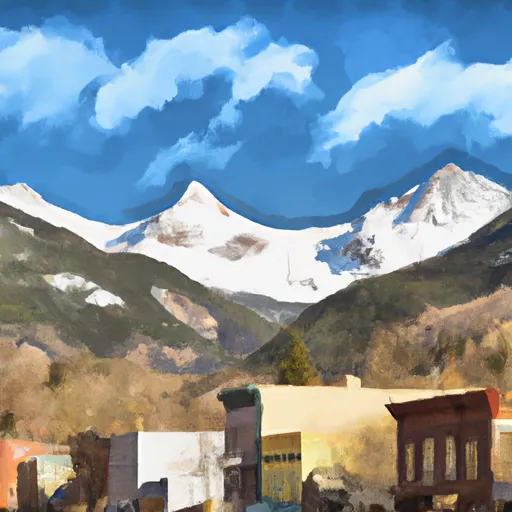-
 Snoflo Premium
Snoflo Premium
Get unlimited access to all our content
With no Ad interruptions! - Start Your Free Trial Login with existing account
Silverton
Eden Index
Climate
5.6
•
Recreation
8.0
•
Community
•
Safeguard
5.0/10

Silverton, Colorado is a charming mountain town nestled in the heart of the San Juan Mountains. It has a high elevation of around 9,318 feet, resulting in a cool, alpine climate. Summers are mild with temperatures averaging around 70°F, while winters bring heavy snowfall and temperatures dropping to freezing or below.
The town's hydrology is shaped by the Animas River, which flows through the valley. The river is known for its stunning turquoise color, thanks to the presence of minerals such as iron and manganese. Additionally, the nearby area is home to several high-altitude lakes and streams, offering ample opportunities for fishing, kayaking, and whitewater rafting.
Outdoor enthusiasts will find a wealth of recreational activities in Silverton. The town acts as a gateway to the San Juan National Forest, granting access to numerous hiking and mountain biking trails, including the renowned Colorado Trail and Alpine Loop. In winter, the area transforms into a winter wonderland with opportunities for skiing, snowboarding, snowshoeing, and snowmobiling. With its breathtaking landscapes and diverse outdoor offerings, Silverton is a haven for nature lovers and adventure seekers alike.
What is the Eden Index?
The Snoflo Eden Index serves as a comprehensive rating system for regions, evaluating their desirability through a holistic assessment of climate health, outdoor recreation opportunities, and natural disaster risk, acknowledging the profound impact of these factors on livability and well-being.
Climate Health Indicator (CHI): 5.6
Silverton receives approximately
1079mm of rain per year,
with humidity levels near 61%
and air temperatures averaging around
0°C.
Silverton has a plant hardyness factor of
4, meaning
plants and agriculture in this region thrive during a short period during spring and early summer. Most
plants will die off during the colder winter months.
By considering the ideal temperature range, reliable water supplies, clean air, and stable seasonal rain or snowpacks, the Climate Health Indicator (CHI) underscores the significance of a healthy climate as the foundation for quality living.
A healthy climate is paramount for ensuring a high quality of life and livability in a region, fostering both physical well-being and environmental harmony. This can be characterized by ideal temperatures, reliable access to water supplies, clean air, and consistent seasonal rain or snowpacks.
Weather Forecast
Streamflow Conditions
Upper San Juan
Area Rivers
Upper San Juan
Snowpack Depths
Upper San Juan
Reservoir Storage Capacity
Upper San Juan
Groundwater Levels
Recreational Opportunity Index (ROI): 8.0
The Recreational Opportunity Index (ROI) recognizes the value of outdoor recreational options, such as parks, hiking trails, camping sites, and fishing spots, while acknowledging that climate plays a pivotal role in ensuring the comfort and consistency of these experiences.
Access to outdoor recreational opportunities, encompassing activities such as parks, hiking, camping, and fishing, is crucial for overall well-being, and the climate plays a pivotal role in enabling and enhancing these experiences, ensuring that individuals can engage in nature-based activities comfortably and consistently.
Camping Areas
| Campground | Campsites | Reservations | Toilets | Showers | Elevation |
|---|---|---|---|---|---|
| East Portal - Curecanti National Rec Area | 15 | 6,557 ft | |||
| Beaver Lake | 11 | 8,750 ft | |||
| Telluride Town Park | 28 | 8,771 ft | |||
| Amphitheater | 35 | 8,254 ft | |||
| Big Cimarron | 10 | 8,667 ft | |||
| Thistledown | 9 | 8,501 ft | |||
| Silver Jack | 60 | 9,117 ft | |||
| Cimarron - Curecanti National Rec Area | 22 | 6,906 ft | |||
| South Rim - Gunnison National Park | 88 | 8,365 ft | |||
| Ridgway State Park | 283 | 7,062 ft |
Nearby Ski Areas
Catastrophe Safeguard Index (CSI):
The Catastrophe Safeguard Index (CSI) recognizes that natural disaster risk, encompassing floods, fires, hurricanes, and tornadoes, can drastically affect safety and the overall appeal of an area.
The level of natural disaster risk in a region significantly affects safety and the overall livability, with climate change amplifying these risks by potentially increasing the frequency and intensity of events like floods, fires, hurricanes, and tornadoes, thereby posing substantial challenges to community resilience and well-being.
Community Resilience Indicator (CRI):
The Community Resilience Indicator (CRI) recognizes that education, healthcare, and socioeconomics are crucial to the well-being of a region. The CRI acknowledges the profound impact of these elements on residents' overall quality of life. By evaluating educational resources, healthcare accessibility, and economic inclusivity, the index captures the essential aspects that contribute to a thriving community, fostering resident satisfaction, equity, and social cohesion.

